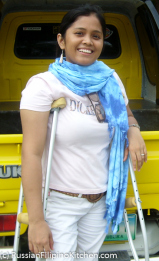
By KIRA DEL ROSARIO, Loveonexcel.com
LOS ANGELES, California — Like most modern long-distance relationships, Mirasol Fajardo Savchenko, a person with post-polio syndrome, met and fell in love with her husband online.
She was then working as a computer programmer at the municipal IT department of Dalaguete in Cebu and the president of the municipal association of PWDs.
After three years of cyber dating and spending short periods of time with her fiancé in the Philippines, Savchenko came to the United States through a K1 or fiancée visa in 2008.
For seven years now, Savchenko, 33, has been a resident of Sacramento, California where she lives with her Russian-American husband Nick and their four children.
Based on the Commission on Filipino Overseas (CFO) records from 1989 to 2013, Savchenko was among the 193,661 Filipinos who immigrated here as spouse or partner of US nationals in that period.
The US was the top destination of these Filipinos, accounting for 43 percent, followed by Japan and then Australia, the same records show.
A foreigner in a new land, Savchenko said the first months here were depressing. “I didn’t have friends, immediate family or relatives. My husband worked most of the time and I was left alone in our apartment,” she said.
Initially she “felt like I made a huge mistake,” and having to acclimatize to four seasons, compared to tropical weather back home, added to the challenge. The cold made her joints hurt, she said.
Savchenko also realized that she didn’t know everything about her husband as their courtship occurred largely online. “There are some aspects that can only be learned and understood once you’re together,” she shared.

She had to learn how to gesture in order to communicate with her in-laws, who immigrated to the US 10 years ahead of her. She also had to get accustomed to the financial system here that relies heavily on credit cards.
But Savchenko seems to have assimilated well. She has also found a creative outlet through her food blog russianfilipinokitchen.com, a testament to the gastronomic and cultural fusion that is her marriage.
Savchenko had polio when she was six months old and uses crutches to support her legs. As a person with disability, she says that life in the US could be challenging. Being away from her family means no support system especially with childcare, a common practice in the Philippines.
Her in-laws live nearby but her mother-in-law takes care of her father-in-law, who also has a disability.
But in many other ways, life here is easier. “In terms of accessibility, there’s a huge difference,” she said, elaborating that owning a family car makes going around “much easier” compared to getting onto the front row seat of a jeepney or boarding a bus and tricycle.
With respect to buildings and establishments, she said, “So far, all buildings and facilities that I’ve been to are all disabled-friendly.” Doors, elevators, ramps and bathrooms are wider and parking lots make it easier for PWDs to move.
When she has her check ups at the OB-GYN, she said she need not to raise herself to a high exam table because “they have chairs that can be adjusted and turned into an exam table.”
When it comes to social tolerance, Savchenko said that most Americans are “very accepting and polite” towards PWDs. She has, however, experienced discrimination from fellow Filipinos.
In her other blog, filipinainusa.wordpress.com she wrote about one incident where she overheard an old Filipino couple at Walmart saying “Naku, ambisyosang pilay yan ano? Gusto makapunta sa Amerika kaya nag asawa ng foreigner. Sure ako matanda din mister niyan (That crippled woman is so ambitious. She wanted to come to the US so she married a foreigner. I’m sure her husband is an old guy).
As a permanent resident, Savchenko does not receive a citizen’s benefit such as a Supplemental Security Income, although her children who are US citizens, are entitled to public benefits.
In California, she said, state benefits such as free education and health care are a big help. Two of her children – Jasmine, 4, and Kevin, 3 – who showed delayed development for example, were diagnosed with autism spectrum disorder last March. Both now attend special education for free.
Another “great thing,” she said is that a school bus takes her children to school and drives them back home everyday. “So ‘di masyadong mahirap sa akin kasi lalabas lang ako tapos tinutulungan na sila ng bus driver (So it’s not too hard for me because I just need to wait with them outside the house and the bus driver helps them),” she said.

The rights of American PWDs are protected under the American Disability Act of 1990 that provides equal opportunities. The law was enacted with the purpose of giving a “clear and comprehensive national mandate for the elimination of discrimination.”
Filipinos are the 12th nationality that has obtained legal permanent resident status in the US from 1820 to 2013 at more than 2.2 million, according to the Department of Homeland Security.
Because the US is known as an immigrant nation, the organization Welcoming America started the celebration of Immigrant Heritage Month (IHM) in June 2014. In his June 6 weekly address, President Barack Obama acknowledged IHM’s second year and recalled growing up in Hawaii with native Hawaiians, Filipinos, Japanese, Chinese and Portuguese.
“One of the remarkable things about America is that nearly all of our families originally came from someplace else. We’re a nation of immigrants. It’s a source of our strength and something we all can take pride in,” Obama said.
Loveonexcel.com is a US immigration blog told from the perspectives of a first generation immigrant and a recent immigrant.
